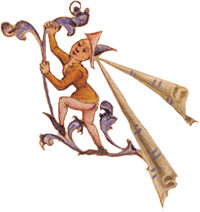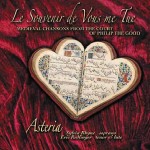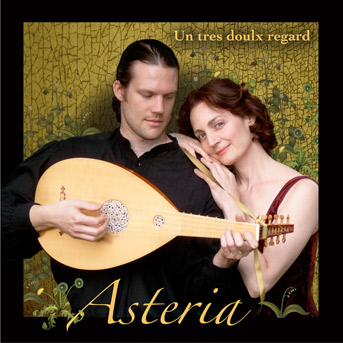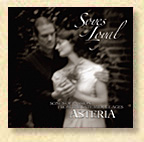








Click on CD above to magnify
Listen to some sample tracks from the cd
Order CD: $15 plus $3 shippingThe chansons on Asteria's debut album are gathered from compositions which were likely performed in the courts of the Dukes of Burgundy at the height of their reign and cultural influence during the mid to late 15th century. As you listen to the work of these masters, let the emotions conveyed in their ancient melodies carry you away, as they did the courtly audiences of the middle ages.
> track listings, texts and translation
> try before you buy - preview the album at magnatune.com100 years before the reign of the Renaissance masters, a new polyphonic art form was taking root in the low countries and making its way across a rapidly transforming Europe. The Burgundian chanson tradition, which reached its apex in the latter part of the 15th century, is much less well known and understood than that of the 16th; however, it was a crucial step in the development of western music, leading out of more chaotic, early polyphonic experiments into the refined, mature polyphony of the high-Renaissance.
At the time the chanson repertoire was created and performed, large orchestras and choirs did not exist, nor did the modern concept of a concert. Period documents often mention individual songs being performed by one or two persons as a diversion in a larger program of entertainment at banquets and other social settings at court. Small, mixed ensembles of voices and instruments were not infrequent, with lute, harp and vielle being among the favorite accompanying instruments.
The verses that make up the bulk of the Burgundian chanson repertoire often seem superficially simple, even trite, and yet they are steeped in a fascinating tradition of elevated poetry that sought to transcend the horror of everyday existence in the middle ages, with its plagues, diseases and death at every turn, creating a temporary mythical reality. Reading court scribes of the period would lead us to believe that every move, meeting and affair was drenched in a fantastical surfeit of emotion and allegorical role-playing. Lords, courtiers, pages — everyone rejoiced, wept and despaired with great frequency and passion. The distinction between fiction and non-fiction writing is in fact barely perceivable, with the 400 year old chivalric tradition still very much the dominant aesthetic even into the 16th century.
Quasi-deification of the “Lady,” appeals for aid to personified figures representing Fate, Death, and Jealousy, and a general willingness to extinguish one’s life at the drop of a hat for one’s principles all find their way into Burgundian poetry in much the same form as in the 13th century verses of the Provencal troubadours. “The memory of you kills me when I cannot see you...” writes Robert Morton in the title composition, while Estienne Grossin asks bluntly in his delightful “Vit Encore”: “...is he not dead yet, this false rascal Then by God, he shall soon die!”
The chansons on Asteria's debut album are gathered from compositions which were likely performed in the courts of the Dukes of Burgundy at the height of their reign and cultural influence during the mid to late 15th century.
A renowned patron of spectacle and art, Philip the Good (1396-1467), with his court centered in present day Lyon, was blessed with great economic prosperity and regional power unrivaled even by the King of France. His prolific court historian Georges Chastellain provides us with much of what we know about this period, including the emotionally charged comings and goings of noble guests and the wondrous fetes that witnessed such spectacles as “a giant, leading an elephant,” mechanical dragons, and one account of a “huge meat-pie from which sprang twenty-eight musicians.”
Every generation wistfully idolizes that which preceded it as being more pure, uncluttered with trouble and complexity. As you listen to the work of these masters, let the emotions conveyed in their ancient melodies carry you away, as they did the courtly audiences of the middle ages, yearning for the romantic utopia of their forbears.
—Asteria

Quant la Doulce Jouvencelle (3.39 mb)
Le Souvenir de Vous me Tue (4.45 mb)
De Los Alamos Vengo Madre (2.68 mb)
Click on CD above to magnify
Listen to some sample tracks from the cd
Order CD: $15 plus $3 shippingAsteria's second collection of medieval French chansons is a fascinating look at the dual image of the "Lady" and the "Rose" in both secular and sacred music of the latter Middle Ages. In this exquisite repertoire the duo continues their exploration of the roots of courtly love and chivalry. Soyes Loyal lifts their interpretive skills to new heights with ravishing poetry and weaving melodies that inspire the senses. Featuring gorgeous music from the mid-fifteenth century by Dufay, Jacques Vide and others!
> track listings, texts and translation
> try before you buy - preview the album at magnatune.comMuch of the courtly poetry from the 12th to the 15th centuries can be summed up, as Robert Morton does in his chanson from the latter 15th century, with one phrase: "Vive Ma Dame!" The Lady, the absolute, flawless, most worthy object of chivalric desire and loyalty, is surely one of the most mysterious and intriguing elements of medieval art. Simultaneously unattainable and unceasingly sought after, she embodies the essence of amour courtois (courtly love) as it was lived and practiced in the medieval courts of northern Europe.
The "Romance of the Rose", the great love epic of this age, sets forth the code of chivalry in intricate detail and becomes a veritable manual for courtly conduct, describing the impassioned pursuit by a lover to win his "rose" through a variety of allegorical situations and encounters. As in the greater part of 15th century verse, the richness and evocativeness of the symbols lend an almost palpable form to their underlying meanings: the unmatched beauty and sensuality of the rose only heightens the allure of the lady it represents, just as its thorny guardian, a giant figure aptly named Danger, lends a larger than life gestalt to the risks of pursuing the lady. The journey the lover must undertake to be worthy of achieving the rose is alternately guided and thwarted by the characters he encounters. Figures representing personified human emotions and traits such as Jealousy, Largesse, and Slander all vie for the lover's allegiance and express their opinions as to the correct course for him to take. It is by accepting or rejecting their advice that he shows himself to be worthy, and in the process teaches us the intricate rules of amour courtois. This work made a huge mark on medieval courtly society, its characters and sentiments still finding their way into song and verse texts more than 300 years after it first appeared. As affirmed by the anonymous author of 'Soyes Loyal' from the middle of the 15th century: "Remain loyal (to Amor) as best you are able - and you shall have the comfort of Sweet Hope!"
But there is another lady, another rose, of no small importance in this period: the Virgin Mary. The literary traditions surrounding the sacred stories are no less marked by their penchant for metaphor and allegory than are those of the secular. In many cases the very same symbols are used with only a thin layer of context distinguishing a profane reference from a sacred one. Popular sacred songs in the vernacular, such as the English carols "There is no Rose of Such Virtue" and "Of a Rose Sing We", existed peaceably alongside secular chansons such as the anonymous 'La Doulce Flour' (the gentle flower) from the early 15th century and the Romance of the Rose itself. In each case it is obvious which rose we are talking about but only because our expectations are clearly defined. Whether there was any actual double-entendre intended in such works, or in the many grand laments of the period, such as the monumental "Dueil Angoisseux," Gilles Binchois' impassioned setting of a woman's grieving on the death of her husband, is never clearly stated by the authors of that period. As with the allusions to the rose, only context separates the worldly interpretation of a work such as Binchois' from the equally plausible interpretation of the work as a lament on the death of Jesus Christ.
In practice, the deliberate merging of sacred and secular in daily life occurred quite often during the latter Middle Ages. In a play presented to an assembled host of nobles during the celebrated Feast of the Pheasant of 1454, Philip the Good used the image of a gigantic ogre dressed as a Turk who menaces a demoiselle dressed in white (a thinly veiled metaphor for the defeat of Christian Constantinople) to allude to his plans for a future crusade. The oaths that Philip manages to extract from his guests are made, in grand chivalric tradition, "aux dames et au faisan," in other words, to the honor of the assembled ladies and to the pheasant. The task at hand is a sacred one, yet the oaths are sworn to a secular icon.
"Soyes Loyal" explores the resonant symbolism that existed in both the secular and vernacular sacred chansons during the close of the medieval period in Europe. The individuals who populated the courts of medieval Europe were highly adapted to a dualistic existence. Their lives were marked by the daily chaos of disease and warfare, on the one hand, and the refinement and grace that accompanied the pursuit of the chivalric ideal, on the other. Praying to the heavenly Lady and then putting on a helm to fight in the name of an earthly lady was perhaps not so strange in this tumultuous epoch. We hope that listening to these works of extraordinary beauty sheds a glimmer of light upon the passions of the age! Vive Ma Dame!
—Asteria

Ne Je Ne Dors (4.35 mb)
Vit Encore Ce Faux Dangier (3.2 mb)
Of A Rose Singe We (lute solo) (1.68 mb)
Click on CD above to magnify
Listen to some sample tracks from the cd
Order CD: $15 plus $3 shippingThe chansons on Asteria's third album are all gathered from one extraordinary manuscript, the celebrated Oxford 213 manuscript currently housed at the Bodleian Library in England. Aside from being the largest collection of 15th century chansons by known composers like Dufay and Binchois, it contains a great number of anonymous works from the earliest period of the the 15th century. Asteria chose to focus on this exquisite body of little-known works for Un tres doulx regard, and many of these songs have never before been recorded before.
> track listings, texts and translation
> try before you buy - preview the album at magnatune.comJust like the shy lover who is knocked off his feet by the merest glance from the object of his affections, the music of the first generation of Burgundian composers at the end of the ars nova is infused with the sweetness and explosive passion of new love. "Un tres doulx regard" - A most sweet glance - is the result of extensive archival research into this little-known period, dating roughly from 1390 to 1420, just before the meteoric rise (and subsequent fall) of Burgundian power and influence that would briefly propel Franco/Flemish art and music to the very apex of European fashion.
At the turn of the 15th century, a common merchant or educated noble in Dijon, Brugge or Lille would have had very little reason to suspect that the next 70 years would bring with them such dramatic developments. War with England, repeated calls for crusades, and the terror of the black death were still very much the order of the day when their new duke, Philip the Bold, a prince of the Valois dynasty of French kings, took as his bride Marguerite of Male, a Flemish princess and the richest heiress in Europe. The unprecedented wealth that subsequently flowed into Burgundian coffers was used to support an increasingly extravagant series of artistic endeavors and cultural achievements that would place Philip's court at the cultural and political center of Europe. It was at this time that the celebrated sculptures of Claus Sluter were realized at the Chartreuse de Champmol in Dijon, and the finest artisans in northern Europe were engaged to beautify Marguerite's elegant country palace in nearby Germolles. Under Burgundian patronage, Christine de Pizan, perhaps the greatest poet of the late middle ages, would leave her enduring mark, and later in the century Jan van Eyk and Rogier van der Weyden would adorn Burgundian spiritual and secular edifices with their best works.
In music, too, much was changing. The bewildering complexity of the ars nova composers was met with a strong, reactionary backlash by the following generation, who eschewed the virtuosic, twisting melodies of their predecessors in favor of more simple, elegant lines and forms. Inspired by their duke's love of chivalric ideals, the music of this early Burgundian period is perhaps the most plainly beautiful of the age, reflecting the more pure and finely distilled poetic traditions of the day.
The theme of these secular chansons is almost invariably that of courtly love, that mysterious and uniquely medieval literary and cultural tradition that places the lady on the highest possible pedestal and prescribes with absolute precision the social roles for noblemen and noblewomen at court. But like the rules of love in any age, there are countless variations and permutations: "Although my beard be grey, may you ï¬nd it in your heart to love me," beseeches an aging knight in "Pourtant se jay la barbe grise." "Give comfort to your lover, for he has served you to the best of his ability!," encourages the text of "Dones confort." And in Johannes le Grant's "Layssies moy coy," the jilted lover requests merely to be left alone in his love-stricken grief: "Don't speak to me of singing - I have better cause to lament!"
When the knight woos his lady, the pain of her initial refusal is utterly bittersweet. The more inaccessible the object of his affections, the greater his passion, and the higher the drama and glory of the pursuit. The troubadours of the preceding age preached the gospel of courtly love as the ultimate human experience, and their ability to convey the passion and despair of love in verse and music - the longing of new love, the agony of love unfulfilled, and the exquisite pain of love itself - was viewed as the pinnacle of artistic expression. Indeed, the voluminous quantities of courtly song and poetry, spanning almost 500 years, attest to the enduring interest that medieval society held for the twists, travails and seeming contradictions of this fascinating tradition.
In the end, things have not changed so very much in the 500 years that have followed; songs about love still predominate, and our lives are still capable of being turned upside-down in the merest instant by "a most sweet glance!"
—Asteria

Pour l'amour de ma doulce amye (4.57 mb)
Entre vous nouviaux maries (2.19 mb)
Mon plus haut bien (5.75 mb)
Click on CD above to magnify
Listen to some sample tracks from the cd
Order CD: $15 plus $3 shippingHaunting the vaults of the municipal library in Dijon, France, is a small volume, its modest grey cover causing it to almost disappear among its neighboring volumes: the Dijon Chansonnier, Ms. 517. Despite its now humble exterior (the original binding has been lost) it contains a veritable treasure trove of some 160 courtly love songs, written in the third quarter of the 15th century, by some of the most famous composers of their day. Largely devoid of the usual ownership stamps that normally accompany such manuscripts, it has perhaps even remained in Burgundy since the time of Duke Charles the Bold, passing from household to household and shelf to shelf, waiting for its treasures to be explored.
> track listings, texts and translation
> try before you buy - preview the album at magnatune.comWhile not as floridly ornate as other famous song books of its day, notably the heart-shaped Chansonnier Cordiforme featured on Asteria's first album of Burgundian chansons, the fanciful, illuminated capitals of the Dijon manuscript flirt playfully with the imagination. Fish, serpents, old ladies and young lovers adorn the elegantly notated pages. But for musicologists, perhaps its most important attribute is that it contains one of the largest known collections of secular chansons by Antoine Busnoys, a highly renowned composer in the employ of the Burgundian dukes.
Asteria at Germolles
Asteria has spent several months in Burgundy each year working with the Dijon manuscript, with a particular focus on Busnoys' songs, translating each piece from the ancient musical notation and medieval French to their modern equivalents. They have also been actively seeking out the late-medieval sites where this music would have been sung, in order to better understand how it may have sounded in the venues for which it was originally written. This journey of discovery first took them, in 2006, to the Chateau de Germolles, near Chalon sur Saone, in southern Burgundy. privately owned since the Revolution, it remains today the best preserved country palace of the Dukes of Burgundy still remaining in Burgundy. Renovated and expanded into a graceful princely abode from an earlier manor house at the end of the 14th century by Duke Philip the Bold for his wife, Margaret of Flanders, Germolles is the perfect reflection of Burgundian elegance and artistic sophistication at the end of the Middle Ages. Indeed, records show that Margaret spent long periods of time resident at the château, cultivating a comfortable and pious lifestyle that wanted for nothing: what better backdrop for rediscovering the Burgundian chanson in the 21st century?

Beginning in 2007, the owners of the Chateau de Germolles have graciously invited Asteria for a residency at the chateau during the month of May each year, and Asteria has profited by rehearsing and performing throughout the castle and its grounds. They have performed for both private and public gatherings in a variety of historical spaces in the château, including in front of the monumental fireplace carved by the great sculptor Claus Sluter and in the private dressing room of Margaret of Bavaria, daughter-in-law to the first duchess of Burgundy. It is here, in this private and intimate space, its original 14th century wall murals by Jean de Beaumetz giving it an otherworldly quality, that Asteria has recorded the present album of exquisite love songs by Antoine Busnoys from the Dijon Chansonnier.
—Asteria

Est-il mercy (7.3 mb)
Je Mesbais de Vous Mon Cuer (9.7 mb)











